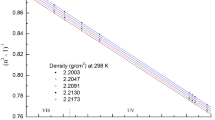Summary
In this paper, the author’s general theory of thermo-optic behaviour is applied to the case of optical glasses. Making use of the dispersion formulæ of Huggins and co-workers, which employs one dispersion frequency for each oxide component, formulæ are developed, which give the rate of change of the refractive index with temperature,dn/dt. Computations made on the basis of these formulæ give fairly correct values ofdn/dt for a large variety of multicomponent optical glasses studied by Pulfrich and by Peters. Although the formulæ givedn/dt fairly correctly for any particular wavelength in the visible, they do not give accurate values for the dispersion ofdn/dt. The discrepancy is shown to be due to the inadequacy of using one dispersion frequency for each component in the dispersion formula. Using two frequencies, one of which is in the remote ultra-violet, and gives only a constant contribution to refractive index, new dispersion formulæ are derived and on their basis bothdn/dt for any wavelength as well as its dispersion are correctly obtained. In addition, the theory also explains qualitatively other observations made on the thermooptic behaviour of optical glasses, such as the anomalous variations ofdn/dt near the annealing and softening temperatures and broadly the correlation between composition and the value ofdn/dt of the glasses. It is inferred that the proportionate variation of the dispersion frequencies of all the components diminishes with fall of temperature, and probably vanishes at very low temperatures, as is the case with crystals like diamond.
Similar content being viewed by others
References
Darwin and WatsonProc. Roy. Soc., A, 1927,114, 474.
GiffordIbid.,, 1915,91, 319; 1922,100, 621
HastingsAm. J. Sci., 1878,15, 269.
HugginsJ. Opt. Soc. Am., 1940,30, 495, 514.
—, Sun and DavisIbid.,, 1942,32, 635.
Morey “The Properties of Glass,”A.C.S. Publications, 1938, Ch. XVI.
PetersJ. Bur. St., 1926,20, 635.
PulfrichWied. Ann., 1892,45, 609.
Ramachandran, G. N.Proc. Ind. Acad. Sci., A, 1947,25, 266, 280, 286, 375.
Ramaseshan, S.Ibid.,, 1946,24, 104, 426; 1947,25, 459.
ReedWied. Ann., 1898,65, 707.
SchutzHandb. Exp. Phys., 1936,16, Part I, pp. 80et seq.
TiltonJ. Bur. St., 1929,3, 619; 1935,14, 393.
Young and FinnIbid.,, 1940,25, 759.
Author information
Authors and Affiliations
Additional information
(Communicated by Sir C. V. Raman,kt.,f.r.s., n.l.)
Rights and permissions
About this article
Cite this article
Ramachandran, G.N. Thermo-optic behaviour of solids. Proc. Indian Acad. Sci. (Math. Sci.) 25, 498 (1947). https://doi.org/10.1007/BF03172551
Received:
DOI: https://doi.org/10.1007/BF03172551




